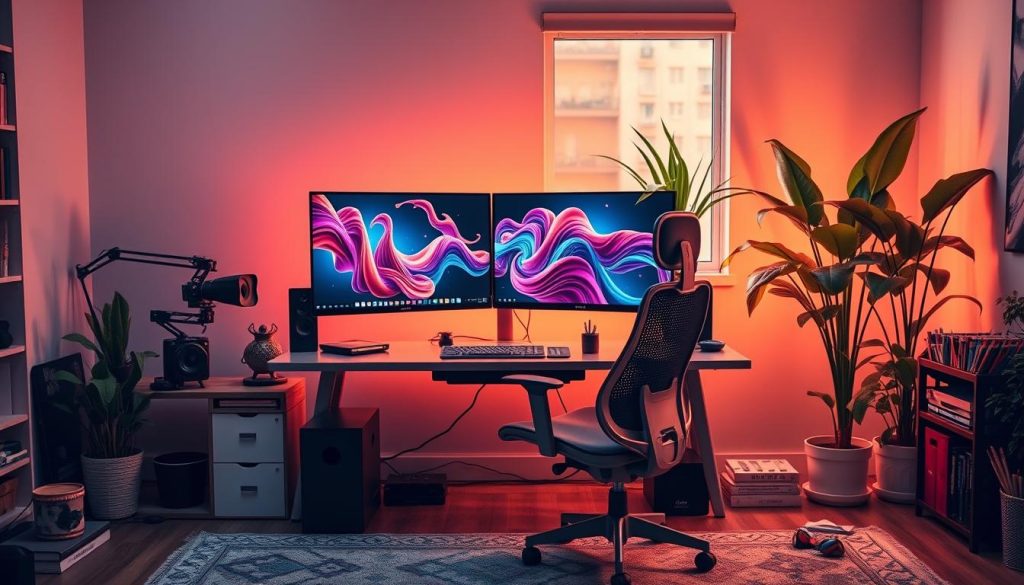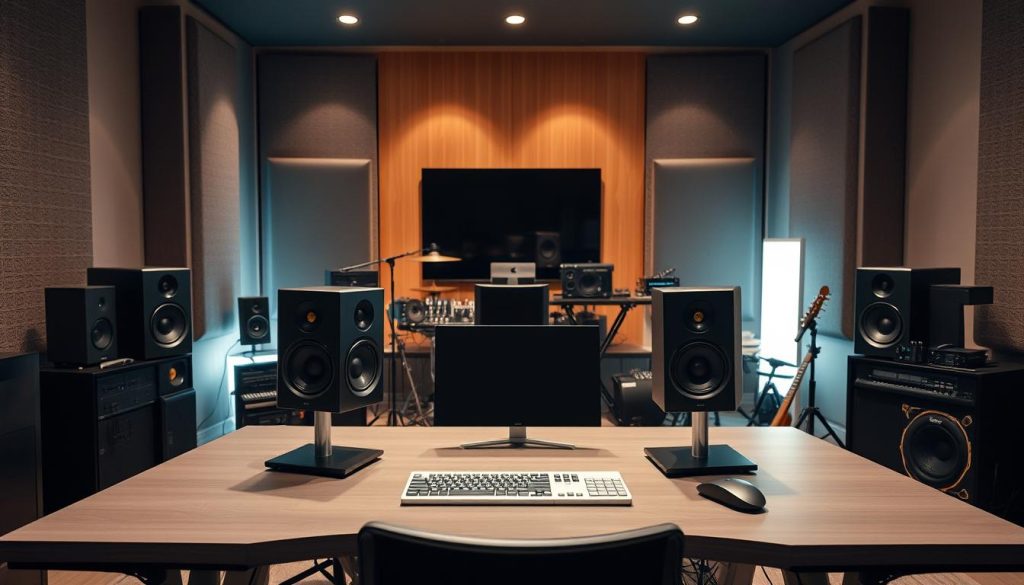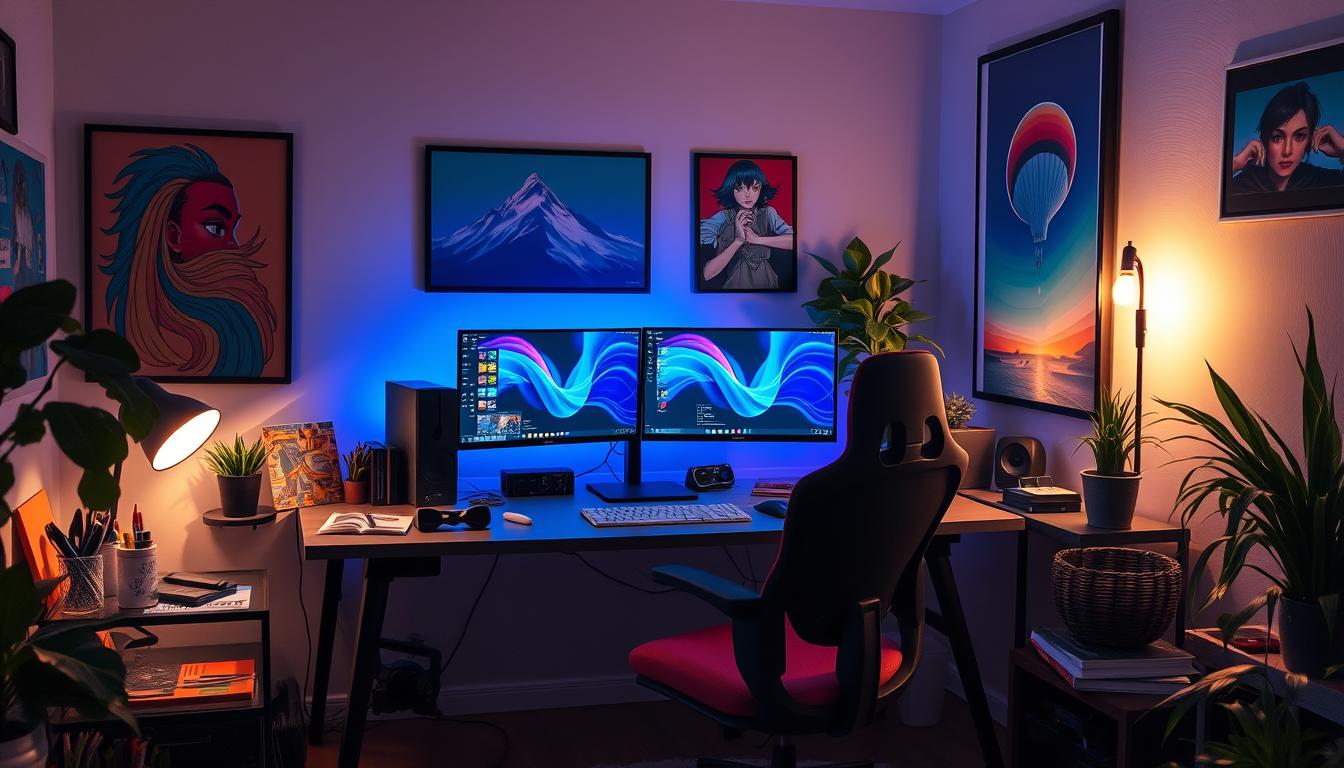Setting up a home studio is easier now than ever. Your computer is key to every project. It links you to a world of recording knowledge online.
When picking a computer, aim a bit higher than the basic specs. Today’s minimums won’t cut it in the future. You’ll also need a Digital Audio Workstation (DAW) for recording, editing, and mixing music on your computer.
Many DAWs are out there, but they all do similar things. They help you make music.
Determine Your Budget for Home Studio Setup
Setting a realistic budget is key when starting your home studio. It’s easy to want the newest gear, but think about what you can afford. Luckily, there are many affordable options that give great results without costing too much.
Start With a Realistic Budget
First, look at your money and set a budget that fits your needs. Think about your income, what gear you already have, and your projects. This helps you spend wisely and avoid buying things you won’t use much.
No Single Gear Defines Quality
The quality of your studio isn’t just about one expensive item. It’s about how all your gear works together. Aim for a balanced setup within your budget, rather than spending a lot on one thing.
With careful planning, you can make a great home studio on a budget. Be creative and look for affordable gear to make your music dreams come true.
Essentials for Your home studio setup

Setting up your home studio needs a strong computer and a good digital audio workstation (DAW). These are key parts of your recording setup. They affect your work and the quality of your music.
A Powerful Computer
Your computer is the core of your home studio. It must handle recording, mixing, and running plugins well. Choose a computer that meets home studio computer requirements and fits your needs now and later. Aim for a fast CPU, lots of RAM, and a big storage drive for your music files and projects.
Digital Audio Workstation (DAW)
You also need a DAW software for beginners for recording, editing, and mixing music. There’s no single best DAW for home studio, but pick one that fits your style. Look at user-friendliness, features, and compatibility with your gear when choosing.
| Computer Specs | Recommended Minimum | Recommended Optimal |
|---|---|---|
| Processor (CPU) | Intel Core i5 or AMD Ryzen 5 | Intel Core i7 or AMD Ryzen 7 |
| RAM | 8GB | 16GB or more |
| Storage | 500GB SSD | 1TB SSD or a combination of SSD and HDD |
Monitor Speakers and Acoustic Treatment

Setting up your home studio starts with your monitor speakers. They are key to how you hear and mix your audio. A good pair is a must for quality sound.
Importance of Good Monitor Speakers
Quality monitor speakers are a must for any serious studio. They let you hear your recordings as they truly sound. Bad speakers can lead to wrong mixing decisions.
Acoustic Treatment for Better Sound
Acoustic treatment is also vital for your studio’s sound. It controls how sound moves in your room. This helps you make better mixing choices by reducing reflections and resonance.
Focus on fixing bass and low-midrange issues first. DIY panels can help, but some spaces need professional treatment. With great speakers and treatment, your studio will sound amazing.
| Feature | Importance |
|---|---|
| Accurate Sound Representation | Crucial for making informed mixing and mastering decisions |
| Controlled Listening Environment | Allows for better decision-making during recording and mixing |
| Mitigating Problem Frequencies | Focus on addressing bass and low-midrange issues |
Recording Gear for Your home studio setup
Setting up your home studio means picking the right gear. This includes the audio interface, microphones, and headphones. Each piece is key to getting great sound.
Audio Interface for Home Studio
The audio interface connects your computer to your gear. It links your speakers, mics, and instruments. Choose based on how many inputs you need and the quality of the preamps. A good audio interface for home studio improves your recording sound.
Essential Microphones for Home Studio
You’ll need at least one or two microphones for different sounds. A large-diaphragm condenser is good for vocals. A small-diaphragm or dynamic is better for instruments and other sounds. Picking the best microphones for home studio boosts your recording quality.
Headphones for Monitoring
Closed-back headphones are key for your studio. They keep sound out of your mics for clean monitoring. A good pair of studio headphones for monitoring helps you make better decisions while recording and mixing.
Choosing the right gear for your audio interface, microphones, and headphones sets you up for success. You’ll be making pro-quality recordings from home.
Setting Up Your Recording Space
Now, you have the gear for your home studio. It’s time to set up your recording space. The right spot for your studio monitors is key. They make sure your music sounds clear and full.
Positioning Studio Monitors
Put your studio monitors in an equilateral triangle shape. Your listening spot should be the third point. This makes your music sound balanced and clear.
Adding things like absorptive panels and bass traps helps too. They make your studio sound better by controlling echoes and bass. This lets you make better music choices.
With your monitors in the right spot and your space treated, you’re ready for a pro-sounding studio. Next, let’s look at setting up your recording gear.

